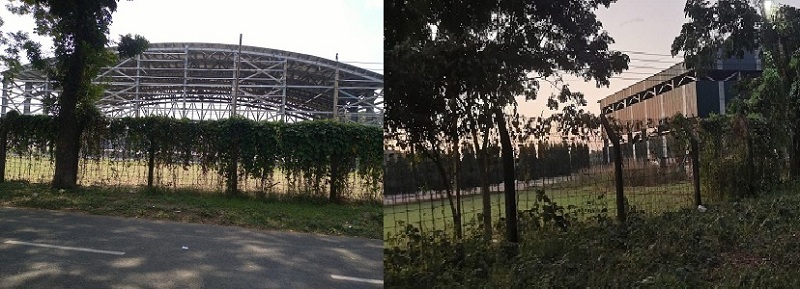Notwithstanding the Indian defence establishment’s reservations, the Bangladesh Air Force (BAF) continues to pursue construction work at the site of the new hangar for fighter jets at Lalmonirhat airbase, even as there are clear indications that a new radar system is being readied for installation at this facility near the India-Bangladesh border.
Bangladesh security sources disclosed to Northeast News that components for the new radar system arrived by truck at the expansive Lalmonirhat airbase about two weeks ago.
Sources said plans were afoot to construct a concrete platform and a commensurate building for emplacing the defence radar system, which would be a considerable upgrade over the existing aging system at Lalmonirhat airbase. There is an existing small concrete structure – the wireless room – about 70 metres from the new hangar. New residential complexes have also come up inside the airbase precincts over the last six months.
Air defence radars provide critical capabilities for surveillance, target acquisition and threat detection. The main components of a military grade radar system include a transmitter, antennas, a receiver and a processor, along with other key parts such as a command-and-control centre, tracking systems, and weapons launchers.
The Lalmonirhat airbase has an old radar system. The new system that is being sought to be built would be close to the older structure. Informed sources said that every month, at least flights involving helicopters and a small plane are operated at Lalmonirhat airbase.
Northeast News had earlier reported that work on a large hangar for parking at least 10-12 fighter aircraft had nearly been completed. The report was published shortly after a three-member team of Indian Military Intelligence officers led by a major general toured Lalmonirhat and the nearby Thakurgaon airbases, besides unidentified sites at Nilphamari and Saidabad – all in Rangpur division – on October 16.
Bangladesh Army chief General Waker-uz-Zaman and a lieutenant general had accompanied the Indian MI team.
Bangladesh security sources admitted that while work on the hangar was stopped for a couple of days following the tour of the Lalmonirhat airbase by the Indian team, construction on the remaining portion of the facility, including the roof and the bay walls, had resumed and “is nearing completion”.
Northeast News had earlier reported that Bangladesh Army’s Master General of Ordinance Branch Major General Abu Bakar Siddique Khan and other senior officers met a four-member team of executives of China Vanguard Co Ltd on May 13 to discuss plans to acquire HQ-17AE surface-to-air missiles (SAMs), JSG radars and FK-3 medium-range surface-to-air missiles (MSAMs).
The JSG-400 TDR radar is a Chinese fire control radar, part of the HQ-9BE missile defence system, used to guide interceptors against ballistic missiles. It was first publicly revealed in an infographic at the 2021 Zhuhai Airshow and has been seen at the CASIC manufacturing facility.
Significantly, on June 18, the BAF commissioned its second GM 403-M long-range air surveillance radar in Bogura. The installation took place about two months after the BAF inducted its first GM 403-M radar with the 71st squadron in Dhaka’s Mirpur.
Developed and built by ThalesRaytheonSystems’ (TRS), the GM-403-M is a fully digital 3D air defence Ground Master radar family, which offers detection from very high to very low altitudes.
ALSO READ: Bangladesh building ‘large hangar’ for fighter jets close to sensitive ‘Chicken’s Neck’
It tracks a wide range of targets from highly manoeuvrable low-flying tactical aircraft to unconventional smaller targets such as UAVs, ensuring a good quality wide-area air picture.
When deployed on site, the radar can be connected to operate as part of a networked air defence “organisation” and can be controlled from a remote location. The radar is credited with a range accuracy of 50 metres.














